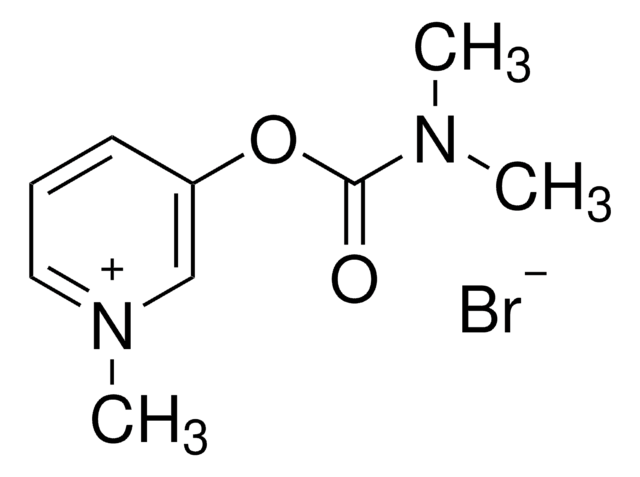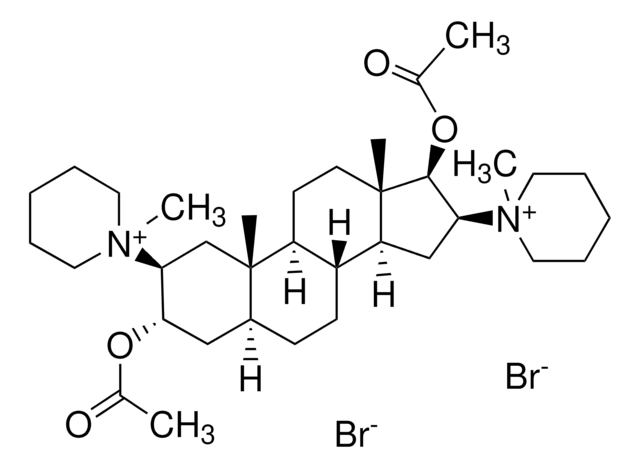Kluczowe dokumenty
N2001
Neostigmine bromide
≥98% (HPLC and titration), powder
Synonim(y):
3-(N,N-Dimethylcarbamoyloxy)-N,N,N,-trimethylanilinium bromide, Prostigmine
About This Item
Polecane produkty
Próba
≥98% (HPLC and titration)
Formularz
powder
kolor
white
mp
175-177 °C (lit.)
rozpuszczalność
H2O: 1 g/mL
ethanol: soluble
ciąg SMILES
[Br-].CN(C)C(=O)Oc1cccc(c1)[N+](C)(C)C
InChI
1S/C12H19N2O2.BrH/c1-13(2)12(15)16-11-8-6-7-10(9-11)14(3,4)5;/h6-9H,1-5H3;1H/q+1;/p-1
Klucz InChI
LULNWZDBKTWDGK-UHFFFAOYSA-M
informacje o genach
human ... ACHE(43)
Szukasz podobnych produktów? Odwiedź Przewodnik dotyczący porównywania produktów
Zastosowanie
- to control reaction specificity of acetylcholinesterase in coronal organ of Botryllus schlosseri.
- to study its effects on abnormal contraction of pyloric circular smooth muscle strips (PCSMS).
- to study its effects on depolarization of bag cell neurons.
Działania biochem./fizjol.
Cechy i korzyści
Hasło ostrzegawcze
Danger
Zwroty wskazujące rodzaj zagrożenia
Zwroty wskazujące środki ostrożności
Klasyfikacja zagrożeń
Acute Tox. 1 Inhalation - Acute Tox. 2 Dermal - Acute Tox. 2 Oral - Eye Irrit. 2 - Resp. Sens. 1 - Skin Irrit. 2 - Skin Sens. 1 - STOT SE 3
Organy docelowe
Respiratory system
Kod klasy składowania
6.1A - Combustible acute toxic Cat. 1 and 2 / very toxic hazardous materials
Klasa zagrożenia wodnego (WGK)
WGK 3
Temperatura zapłonu (°F)
Not applicable
Temperatura zapłonu (°C)
Not applicable
Środki ochrony indywidualnej
Eyeshields, Faceshields, Gloves, type P2 (EN 143) respirator cartridges
Wybierz jedną z najnowszych wersji:
Masz już ten produkt?
Dokumenty związane z niedawno zakupionymi produktami zostały zamieszczone w Bibliotece dokumentów.
Klienci oglądali również te produkty
Nasz zespół naukowców ma doświadczenie we wszystkich obszarach badań, w tym w naukach przyrodniczych, materiałoznawstwie, syntezie chemicznej, chromatografii, analityce i wielu innych dziedzinach.
Skontaktuj się z zespołem ds. pomocy technicznej










